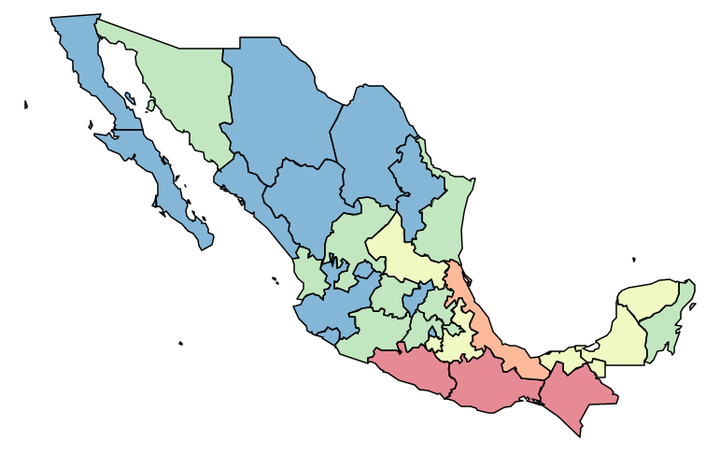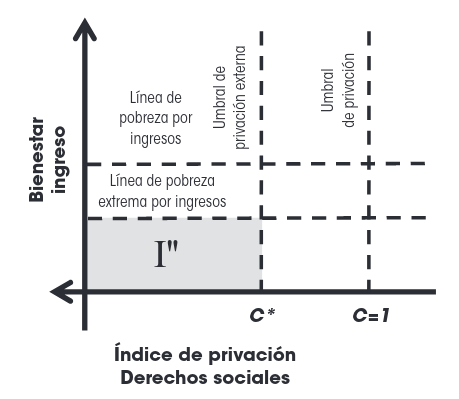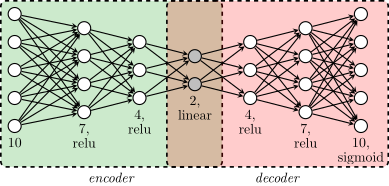Poverty in Mexico 2018

This is an analysis of the Coneval’s data for the measurement of poverty in Mexico in 2018, the data are free and can be found in https://www.coneval.org.mx/Medicion/MP/Paginas/Programas_BD_08_10_12_14_16_18.aspx.
History
Human Poverty Index
Before the arrival of the modern Multidimensional Poverty Index, the poverty was measured through the Human Poverty Index (HPI), as a complement of the Human Development Index (HDI) and was first introduced in 1997. This index is was actually two different indexes, the HPI-1 for developing countries and HPI-2 for high-income OECD countries (https://en.wikipedia.org/wiki/Human_Poverty_Index).
HPI-1
The HPI-1 is given by the formula:

where
- $P_1$: Probability at birth of not surviving to age 40 (times 100).
- $P_2$: Adult illiteracy rate.
- $P_3$: Arithmetic average of 3 characteristics:
- The percentage of the population without access to safe water.
- The percentage of population without access to health services.
- The percentage of malnourished children under five.
HPI-2
The HPI-2 is given by the formula:

where
- $P_1$: Probability at birth of not surviving to age 60.
- $P_2$: Adults lacking functional literacy skills.
- $P_3$: Population below income poverty line (50% of median adjusted household disposable income).
- $P_4$: Rate of long-term unemployment (lasting 12 months or more).
Multidimensional Poverty Index
In 2010 the methodologies to calculate the HDI and to measure the poverty changed, and the Multidimensional Poverty Index was introduced, being Mexico pioneer in the development of the methodology for the last one. These methodology was developed by the Consejo Nacional de Evaluación de la Política de Desarrollo Social (Coneval) (National Council for the Evaluation of Social Development Policy) which is an autonomous institution that attempts to evaluate the social-political situation of Mexico and measured the poverty in the country.
History of the Multidimensional Poverty Index in Mexico
An detailed story of the development of the Multidimensional Poverty Index can be found in https://www.coneval.org.mx/Medicion/MP/Documents/Como_logro_construir_la_medicion_de_Coneval%20(1).pdf. Here, I just present a resume.
In 2001, the Federal Government organized the international symposium “Pobreza: Conceptos y Metodologías” (“Poberty: Concepts and Methodologies”), realizing that it was not consensus on the methodology to measure the poverty, as a result of this symposium the Federal Government assumed the responsibility of creating an official methodology to measure the poverty. In the same year the Comité Técnico para la Medición de la Pobreza (CTMP) (Technical Comitee for the Measurement of Poverty) was created by the Federal Government to create an indicator with the following requirements:
- To be simple and easy to communicate.
- To respond to common sense.
- To be statistically robust.
- To be easily replicable.
Poverty indicators where published in 2002 and 2004 by the Federal Government. However, there was general distrust in the statistics published by the government. This distrust motivated the creation of the Coneval as a public and autonomous institution, starting its operations in 2006. For the next three years the Coneval created a theoretical.methodological framework to established the criteria for the definition, identification and measurement of the poverty from a multidimensional perspective, using information generated by the Instituto Nacional de Estadística y Geografía (INEGI) (National Institute of Statistics and Geography) through the Módulo de Condiciones Socioeconómicas (MCS) (Module of SocioeconomicsConditions) de la Encuesta Ncional de Ingresos y Gastos de los Hogares (ENIGH) (National Survey of Home’s Incomes and Expenses), introduced in 2008 and allowing the computation of Multidimentional Poverty Index in the same year. This survey has a periodicity of two years for each state and with information for each municipality every five years.
The construction of the methodology was done with the cooperation of national and foreign researchers and institutions, an extensive list can be found in https://www.coneval.org.mx/Medicion/MP/Documents/Como_logro_construir_la_medicion_de_Coneval%20(1).pdf, some of the institutions that participated are those presented in the next figure, which I took from the same source.

As a result of all the described efforts, the Coneval elaborated the “Medología para la medición multidimencional en México” (“Methodology for the multidimensional measurement in Mexico”), whose third edition can be found in https://www.coneval.org.mx/InformesPublicaciones/InformesPublicaciones/Documents/Metodologia-medicion-multidimensional-3er-edicion.pdf . I personally find this document really well-written, including 4 appendices explaining the statistical methodology to calculate all the indexes and statistics used in the study.
Other countries like Colombia, Chile, Philippines, Bhutan, Morocco, Algeria, Tunes, South Africa, England and Peru have implemented their multidimensional poverty index based on the methodology developed in Mexico. And, like I said this methodology is the official one in the UN since 2010, with Mexico being the first country to implement it.
Data Analysis
About the Data
Here I present my own analysis of the Coneval’s data for the measurement of poverty in Mexico in 2018, the data are free and can be found in https://www.coneval.org.mx/Medicion/MP/Paginas/Programas_BD_08_10_12_14_16_18.aspx. Note that this is not the methodology used by the Coneval to calculate the multidimensional poverty index.
I am going to focus just on 10 indicators available in the data set, and I’ll do the analysis at a state level. These indicators can be divided in two categories:
Social Rights
- Basic education (ic rezedu)
- Access to health services (ic asalud)
- Access to social security (ic segsoc)
- Home’s quality and space (ic cv)
- Access to basic services at home (ic sbv)
- Access to quality food (ic ali)
Two global indicators are calculated:
- Privation (carencias). This is binary variable, if a person does not have access to at least one of the previous social rights, then privation equals one. On the other hand, if that person enjoys all the previous rights, privation equals zero.
- Extreme privation (carencias3) This is a binary variable, if a person does not have access at least three of the previous social rights, then extreme privation equals one, On the other hand, if a person has access to at least two of the previous social rights, extreme privation equals zero.
Economic Well-being
For these indicators, it is used the income per capita and the prices of basic food to generate two thresholds:
- Poverty line by income (plb). This is a binary variable, if a person can hardly pay for the basic needs then this variable is one, otherwise it is zero.
- Extreme poverty line by income (plb m). This is a binary variable, if a person cannot pay for needs even using all its resources, then that person lives in extreme poverty and this variable equals one, otherwise it is zero.
Other variables, that I do not include in this analysis are related with the inequality in a society and correspond to a third category of variables. Two of these variables (among others) are:
Society
- Gini coefficient in income
- Access to paved roads
By the way, based on the on the poverty line income and the privation indicators, it is possible to make the following graph, classifying the people in four different categories.
- Category I: In this category are those people whose income is beyond the poverty line and who does not have any privation.
- Category II: In this category are those people that are moving out of poverty, in this category are those people whose income is beyond the poverty line, but face some privation. The idea is that they will eventually solve the privation(s) they might face with the income that they have.
- Category III: In this category are those people who are vulnerable to face poverty, in this category are those people who does not face any privation, but since they their income is under the poverty line, they might face some privation(s) in the future
- Category IV: In this category are those people who live in poverty, who face some privation and whose income is below the poverty income line.

On the other hand, the extreme poverty line and the extreme privation indicator allows the identification of people who live in extreme poverty.

The Analysis
The autoencoder (AE) and the construction of a poverty index
To begin the analysis I consider the average for over each variable for each state in Mexico. So each state is represented by a 10-dimensional vector representing the percentage of population that satisfies the definition of the variable. Together with the states of Mexico, I created two hypothetical entities named “Dystopia” and “Utopia”. Dystopia would be a place where no one has basic education, access to health services, social security, etc. and where everybody’s income is below the extreme poverty line. On the other hand, Utopia is a place where everybody enjoys all the social rights and where no one lives below the poverty line by income.
With this data I trained an autoencoder with the following architecture:

I take advantage of the overfitting power of the neural networks, and use an autoencoder with the capability to project all the points into and almost perfect line in two dimensions, ordering the states and the fictitious entities of utopia and dystopia. This order follows the common sense with the industrialized states of the North being the closest to utopia while the states of the South being the farthest. The first principal component in this two dimensional representation is going to be that line, so I proceed to calculate the first principal component and project the encoder representation into this line. I use the value of the first principal component for each entity to construct a poverty index based on the autoencoder, which I called the “AE poverty index”, where the first component of utopia corresponds to 0 in the AE poverty index and the first component of dystopia to 1 in the AE poverty index, the AE poverty index of the states are calculated proportional to their first principal component. The next graphs show these values and the line representing the first prncipal component in the non-linear representation generated by the encoded portion of the autoencoder.
AE, colors considering Dystopia and Utopia
In this graph I have taken the values of dystopia and utopia to build the color gradient, showing the condition of every state in comparison to the worst and best scenarios.
Map of Mexico, colors considering Dystopia and Utopia
A map of Mexico showing the AE poverty index, where the color gradient is based on utopia and utopia can be found here: Map of poverty in_Mexico, colors considering Dystopia and Utopia.
AE, colors considering just Mexico
In this second graph I have used the AE poverty index of the states to create the color gradient, which allows a better comparison of the inequality between states.
Map of Mexico, colors considering just Mexico
A map of Mexico showing the AE poverty index, where the color gradient is based on the Mexican statets can be found here: Map of poverty in_Mexico, colors considering just Mexico.
Use of PCA to explain the poverty index
The problem on the use of may machine learning algorithms like neural networks is their black-box flavor. In this case, for example, we cannot extract a direct interpretation of the AE poverty index even while it follows the common sense. In an attempt to give some interpretation to this index I decided to do a PCA on the 10-dimensional vectors that represent each state, and decided to use the first two principal components to show a linear representation of the observations.
Taking advantage of the loads used to construct each component we can create a biplot, which might give some interpretation to the index. We can see that the first principal component is a weighted mean of the variables with the variable “Access to basic services at home” has the largest weight/load. Since the principal components try to find the directions of maximum variation in the data, this might suggest that the principal inequality between states is the access to basic services at home. On the other hand the indicator “Access to health services” is the variable with the lowest weight/load suggesting that most of the states have a similar value for this variable.
The second principal component is a comparison between the variables, however I find difficult to give an interpretation to this component, give an interpretation is especially difficult when you observe that both distopia and utopia are on the positive side of the second principal component. Hence, I find the comparison made by the second principal component spurious.
PCA, colors considering Dystopia and Utopia
Biplot
Histograms
In this section I the histogram for the 5 variables that I personally consider to be the most imperative to be reduced: Privation, Extreme Privation, Poverty by Income, Extreme Poverty by Income and Lack of Food.